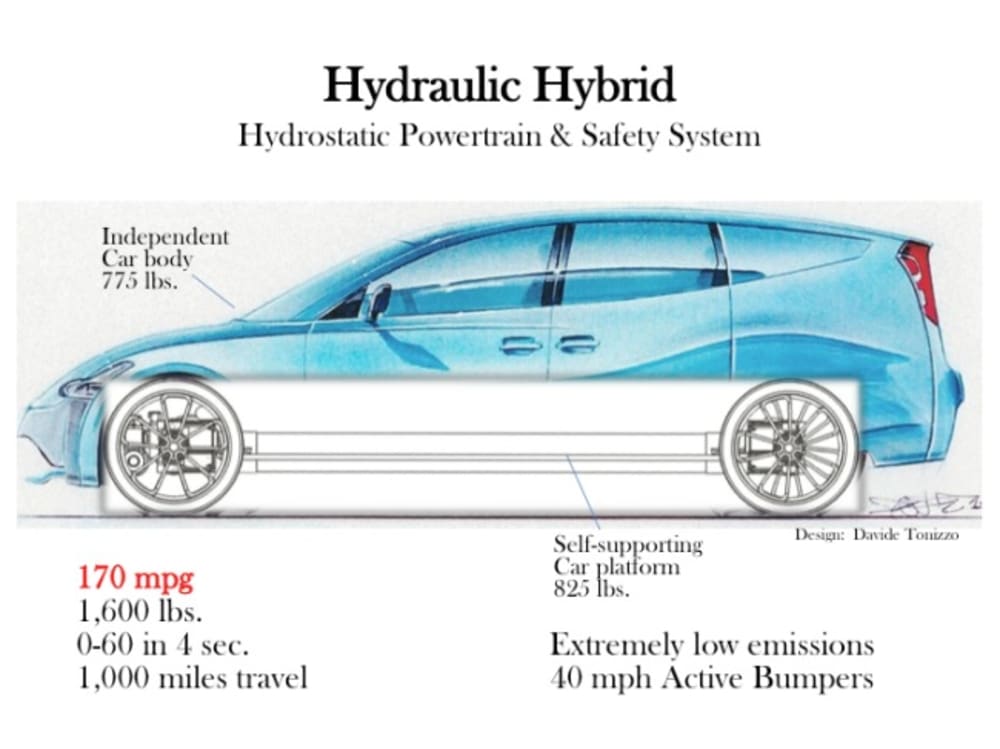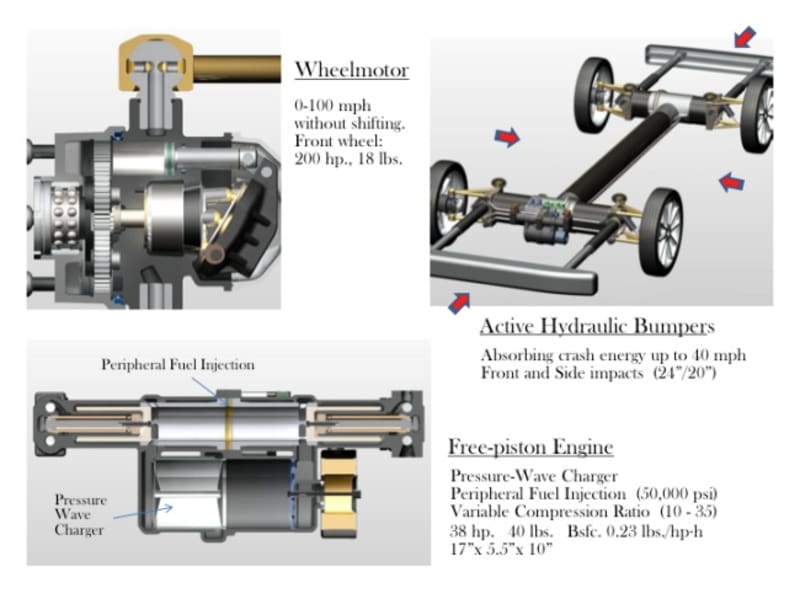Future cars require significant improvements in fuel consumption, emissions and safety. So far, they have been obtained through a more than proportional increase in complexity and cost. The new hydrostatic powertrain shows drastic improvements in all three areas and for reduced costs.
Conventional cars use around 14% of the energy for driving. The other 86% are lost as radiated heat from the engine, brakes and exhaust. The high losses occur because of the high weight and air drag, a large engine running inefficiently at various speeds and powers, and the loss of all braking energy.
The proposed 5-seat Hydraulic Hybrid weighs 1,600 lbs. (-50%), is more fuel efficient (170 mpg, NEDC) less polluting (-85%) and safer. The car consists of a drivable powertrain platform (770 lbs.) and car body. The powertrain, using pressurized fluid to transmit the power, consists of a hydraulic free-piston engine, an accumulator storing the fluid from the engine, and hydraulic wheel motors to drive and brake the car. The very rigid accumulator builds the backbone of the self-supporting platform. Active hydraulic bumpers are attached to it and extend automatically before an impact occurs absorbing the crash energy from speeds up to 40 mph. The powertrain requires little space, and the body becomes light and simple.
The small engine (38 hp.) charges the accumulator efficiently at nearly constant speed and power and will be turned off when the accumulator is filled. The fluid drives the continuously variable wheel motors from a standstill to maximum speed (100 mph.). When braking, the motors (580 hp.) are reversed and pump the entire braking energy back into the accumulator. They accelerate the car from 0-60 mph in less than 4 sec. and are lighter than the disk brakes they replace.
The engine is a 1-cylinder, 2-stroke free-piston Diesel engine with opposed pistons, an exhaust gas driven pressure-wave charger, and ultra-high pressure (50.000 psi) peripheral fuel injection system. This configuration provides an improved piston velocity profile around TDC and a continuously adjustable compression ratio, allowing for the use of all combustible fuels and gases. High thermal efficiency, noticeably reduced heat and friction losses, and significantly improved atomization and distribution of the fuel result in low consumption (-25%) and reduced emissions. The expected reduction in CO2 (-85%) is proportional to the fuel consumed. A nearly elimination of NOx and soot is expected since tests by research institutes (SWRI, TU Karlsruhe) with less sophisticated injection systems have already reached comparable results.
The hydraulic motor is a swashplate-type axial-piston motor with 32° tilt angle (+50%) and higher speed range (+60%), increasing the operating range by a factor of 5 and power/weight ratio by a factor of 6. The combustion engine module (44 lbs.) is exchangeable with a battery driven electric-hydraulic module (88 lbs.) for emission-free operation for city driving.
Current manufacturing methods are applied, and costs are expected to be lower due to the significantly reduced number of parts and material used (-50%).
Valentin
Like this entry?
-
About the Entrant
- Name:Ingo Valentin
- Type of entry:individual
- Software used for this entry:Solid Works
- Patent status:patented








